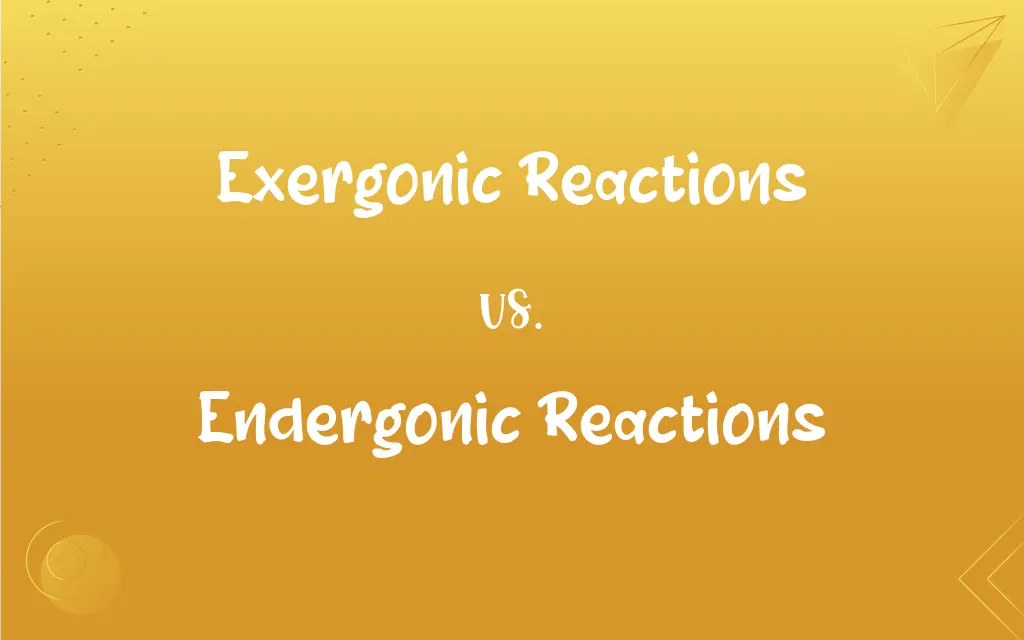Exergonic Reactions vs. Endergonic Reactions: What's the Difference?
Edited by Janet White || By Harlon Moss || Updated on October 19, 2023
Exergonic reactions release energy, while endergonic reactions absorb energy.

Key Differences
Exergonic reactions are chemical processes that result in the release of energy. In these reactions, the energy of the products is lower than that of the reactants. Endergonic reactions, in contrast, are chemical reactions that require an input of energy. In these reactions, the energy of the products is higher than the energy of the reactants.
In terms of thermodynamics, exergonic reactions have a negative Gibbs free energy change, signifying that they are spontaneous and favorable under given conditions. Endergonic reactions, however, have a positive Gibbs free energy change, indicating they are non-spontaneous unless driven by external factors.
When considering metabolic pathways in living organisms, exergonic reactions often provide the necessary energy for endergonic reactions. The coupling of an exergonic reaction with an endergonic reaction allows for energy transfer, facilitating processes like the synthesis of ATP in cells. Endergonic reactions, on the other hand, often represent cellular activities like muscle contractions or active transport that consume energy.
While exergonic reactions tend to proceed on their own due to their energy-releasing nature, endergonic reactions often require a push or activation energy to initiate. This makes enzymes crucial in biological systems, as they can lower the activation energy and catalyze both exergonic and endergonic reactions.
Comparison Chart
Energy Dynamics
Release energy.
Absorb energy.
ADVERTISEMENT
Gibbs Free Energy Change
Negative.
Positive.
Spontaneity
Spontaneous.
Non-spontaneous unless driven by external factors.
Relation to Metabolic Pathways
Often provide energy for endergonic reactions.
Consume energy from exergonic reactions.
Need for Enzymes
Require enzymes to increase the rate.
Require enzymes to lower the activation energy and facilitate the reaction.
Exergonic Reactions and Endergonic Reactions Definitions
Exergonic Reactions
Reactions that are thermodynamically favorable.
Exergonic reactions, like combustion, are spontaneous under given conditions.
ADVERTISEMENT
Endergonic Reactions
Chemical reactions that absorb energy.
Photosynthesis is an endergonic reaction that absorbs sunlight.
Exergonic Reactions
Energy-releasing chemical processes.
The hydrolysis of ATP into ADP is an exergonic reaction.
Endergonic Reactions
Reactions with products having higher energy than reactants.
The active transport of ions across a cell membrane is driven by endergonic reactions.
Exergonic Reactions
Processes with a negative Gibbs free energy change.
The breakdown of glucose is an exergonic reaction as it has a negative ΔG.
Endergonic Reactions
Reactions that are thermodynamically unfavorable.
Endergonic reactions, like protein synthesis, require external energy sources.
Exergonic Reactions
Reactions with products having lower energy than reactants.
Digestive enzymes catalyze exergonic reactions to break down complex molecules.
Endergonic Reactions
Processes with a positive Gibbs free energy change.
The synthesis of glucose from carbon dioxide and water is an endergonic reaction.
Exergonic Reactions
Chemical reactions that release energy.
Cellular respiration is an exergonic reaction that releases energy in the form of ATP.
Endergonic Reactions
Energy-consuming chemical processes.
The formation of ATP from ADP is an endergonic reaction.
FAQs
Do exergonic reactions have a positive or negative Gibbs free energy change?
Exergonic reactions have a negative Gibbs free energy change.
What's the primary difference between exergonic and endergonic reactions?
Exergonic reactions release energy, while endergonic reactions absorb energy.
Are endergonic reactions spontaneous?
No, endergonic reactions are non-spontaneous unless driven by external factors.
Which reaction, exergonic or endergonic, requires an external energy source?
Endergonic reactions require an external energy source.
Do exergonic reactions need an initial energy input?
While they are spontaneous, they might require activation energy to start, which can be lowered with enzymes.
What's a daily life example of an endergonic reaction?
Photosynthesis in plants is an endergonic reaction.
Is the combustion of wood an exergonic reaction?
Yes, combustion is an exergonic reaction as it releases energy.
Can the terms exergonic and endergonic be applied to reactions outside of biology?
Yes, they can be applied to any chemical reaction based on energy dynamics.
Can enzymes facilitate both exergonic and endergonic reactions?
Yes, enzymes can catalyze both types of reactions.
How are exergonic reactions related to ATP production?
Exergonic reactions often release energy used for the synthesis of ATP.
Are endergonic reactions always non-spontaneous?
Typically yes, but they can be driven to occur when coupled with exergonic reactions.
Why are endergonic reactions important in cells?
They drive processes that require energy, such as muscle contractions or synthesis of complex molecules.
What's a common biological example of an exergonic reaction?
Cellular respiration is a common exergonic reaction.
Is the breakdown of glucose exergonic or endergonic?
The breakdown of glucose is exergonic.
How do enzymes impact the rate of both exergonic and endergonic reactions?
Enzymes lower the activation energy, increasing the rate of both reaction types.
Do exergonic reactions always release heat?
Not always; while many do release heat, others release energy in different forms, like light.
In which reaction is energy typically stored, exergonic or endergonic?
Energy is typically stored during endergonic reactions.
What role do exergonic reactions play in metabolism?
They often release energy that powers endergonic reactions within metabolic pathways.
Are all endergonic reactions in the body driven by exergonic reactions?
While many are, some are driven by external energy sources like sunlight in photosynthesis.
Can an endergonic reaction occur on its own?
It requires an energy input, often coupled with an exergonic reaction or an external energy source.
About Author
Written by
Harlon MossHarlon is a seasoned quality moderator and accomplished content writer for Difference Wiki. An alumnus of the prestigious University of California, he earned his degree in Computer Science. Leveraging his academic background, Harlon brings a meticulous and informed perspective to his work, ensuring content accuracy and excellence.
Edited by
Janet WhiteJanet White has been an esteemed writer and blogger for Difference Wiki. Holding a Master's degree in Science and Medical Journalism from the prestigious Boston University, she has consistently demonstrated her expertise and passion for her field. When she's not immersed in her work, Janet relishes her time exercising, delving into a good book, and cherishing moments with friends and family.































































